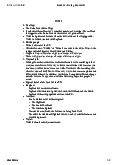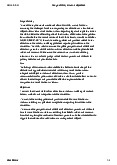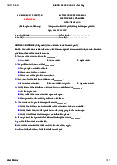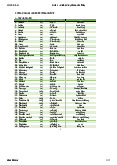








Preview text:
REVISION ON CONTRASTIVE ANALYSIS THEORY
1. Which hypothesis states that the structure of the first language affects the acquisition of the second language?
2. What is the major assumption of Structuralism?
3. State the major assumption on which CAH is founded?
4. State the definition of language transfer? (Clue: Odlin (1989)
5. What are the two main forms of language transfer? Provide examples.
6. State six assumptions that the CAH was based on, summarized by Gass and Selinker (1994: 60):
7. What are the three versions of CAH?
8. What are the claims of the Strong Version of CAH?
9. In what way can similarity/difference and TC be distinguished?
10. In what way can equivalence and TC be distinguished?
11. State 4 major steps of the procedures of CA. PRACTICE
1. Make a description of the lexical item “Giả” and its equivalents in English, using a unilateral CA.
2. Examine the data below and answer the questions. Vietnamese/English pair:
Tối qua cô ấy mệt. (Hanoi dialect) Last night she was tired.
Cô ấy đã đọc xong cuốn sách này.
She has finished reading this book.
Hôm qua anh ấy bị chó táp.
He was snapped at by a dog yesterday.
i) Juxtapose the two pair of sentences and compare to state how explicit Vietnamese is
compared to English in the translationally-equated pair of sentences in rank of sentence,
clause, phrase, word, morpheme. Contrasted ranks S Cl. Phr. Wd. Morph. Contrasted sentences Tối qua cô ấy mệt. 1 She was tired yesterday. Contrasted ranks S Cl. Phr. Wd. Morph. Contrasted sentences
Cô ấy đã đọc xong cuốn sách này. She has finished reading this book. Contrasted ranks S Cl. Phr. Wd. Morph. Contrasted sentences Hôm qua anh ấy bị chó táp. He was snapped at by a dog yesterday Suggested answer:
i) Use the figure below for the comparison of the two sentences in terms of rank scale Contrasted ranks S Cl. Phr. Wd. Morph. Contrasted sentences
Tốối qua tối đã đóng ch c c ặ a tr ử c đ ướ ể 1 1 2 12 ng a k ừ tr ẻ m. ộ
Yesterday I locked the door tightly to 1 1 2 9 prevent burglaries.
ii) Make a comment about about the explicitness of English sentence and the Vietnamese one:
The two sentences are unit identical down to the rank of phrase. Now they begin to to diverge: the
English sentence employs 9 words while the Vietnamese one uses 12 words. At the morpheme level,
the imbalance is reversed: the English sentence employs 15 morphemes whereas the Vietnamese
one uses 12 as presented follows.
Tốối /qua/ tối/ đã /đóng/ ch c /c ặ a /tr ử c/ đ ướ / ng ể a /k ừ /tr ẻ m/ ộ
1 2 3 4 5 6 7 8 9 10 11 12 morphemes
Yester/day/ I/ lock/ed/ the/ door/ tight/ly/ to/ pre/vent/ burglar/i/es
1 2 3 4 5 6 7 8 9 10 11 12 13 14 15 morphemes
English is more synthetic
Vietnamese is more analytic 2
3. Examine the sentence below and answer the following questions … đôi mắt của nó
tất cả mọi người xung quanh đều làm cho sợ hãi.
i) List out possible translational equivalents in English for the Vietnamese sentence
ii) Identify the causative verb type of the English translational equivalents for the
Vietnamese causative verb (làm cho sợ hãi) in terms of morphological, syntactic, lexical categories.
E.g. làm/trấn an = to make s.b calm (down) (+ syntactic/analytic)
= to calm s.b (down) (+ lexical)
PLEASE CONSULT THE SUGGESTED ANSWER BELOW
i) List out possible translational equivalents in English
1) His eyes made everybody afraid.
2) His eyes frightened everybody. 3) His eyes scared everybody.
ii) Identify the causative verb type of the English translational equivalents for the
Vietnamese causative verb (làm cho sợ hãi) in terms of morphological, syntactic, lexical categories. Types of causative Syntactic/Analytic Morphological Lexical verb Make s.b. afraid + Frighten s.b + Scare s.b +
iii) Which type of causative verbs in English (mentioned in ii) has most similarities in
terms of syntactic features (word order, sentence element, number of words/morphemes) as those in Vietnamese?
Make s.b. afraid: Syntactic/Analytic
iv) To show the similarities between this type of causative verb (mentioned in iii) in
English and Vietnamese, please draw a table to represent the syntactic features of the
causative verbs in the two sentences. Subject Causative verb Object Complement đôi mắt của nó làm cho
tất cả mọi người xung đều sợ hãi quanh His eyes Made everybody Afraid Causer Causative process Causee Resulting state 3
4. Please list all the members in the field of “eat” in English and “ăn” in Vietnamese (at least
four members) and answer the following questions
i) Make a matrix of the semantic features of each of the members of “eat” and “ăn”
ii) Then match each members of the group in the two languages as the semantic or/and
translational equivalence, e.g. devour ≈ (ăn) ngấu nghiến
PLEASE CONSULT THE SUGGESTED ANSWER BELOW.
Members in the field of “eat” in English semantic makes a lot Small very quickly, very quickly eat feature of noise amounts of swallowing it or in a way something food by in big pieces that people quickly taking very do not because small bites consider you are Members of polite very hungry “eat” Wolf + Munch + Nibble + Devour + Gobble +
Members in the field of “ăn” in Vietnamese semantic makes a lot Small very quickly, very quickly eat feature of noise amounts of swallowing it or in a way something food by in big pieces that people quickly taking very do not because you Members of small bites consider are very “ăn” polite hungry Ngốn + Nhai tóp tép + gặm, nhắm, rĩa + ngấu nghiến + nuốt, tộng + English e.g. devour wolf Munch Nibble Gobble … Vietnamese ngấu ngốn Nhai tóp gặm, nhắm nuốt, tộng … nghiến tép
5. Please list all the members in the field of “break” in English and “làm vỡ” in Vietnamese
(at least four members) and answer the following questions
i) Make a matrix of the semantic features of each of the members of “break” and “làm vỡ”
ii) Then match each members of the group in the two languages as the semantic or/and
translational equivalence, e.g. break ≈ làm vỡ
ii) You can use a matrix to show the collocation of the verbs in English and Vietnamese as follows: 4 5 burst smash(ed) shatter(ed) crack(ed) chip(ped) snap(ped) crush(ed)(ing) break broke) (broken) I’m afraid her leg is + in two places The wrecked ship will +
up on the rocks if the winds gets any stronger .
The cat knocked over the cup and + + it. The angry crowd (+) +
all the windows in the street if they passed.
The glass fell on the stone floor and + + into a hundred tyiny pieces. The brittle rock +
under the force of the explosion.
Juice may be extracted from fruit by + it. Someone sat on my flowers and + them. I can never +
Brazil nuts because they are so hard. The plate isn’t broken, only + + .
The ice was tight-packed around the door and had to be + away a little at the time.
The wind was so strong that several branches + + clean off the big oak tree. He + +
the twig in two so that they would fit into the fire.
I had my shopping in a plastic bag which +
under the weight just as I was getting onto the bus. The nasty boys +
all the pretty balloon we had blown up for the party. The river has +
its banks and flooded a wide area. 6
iii) Provide the Vietnamese translational equivalents for the English sentences with the collocation of ‘breaking verbs’ and state how
many members of ‘breaking verbs’ in Vietnamese can be used for the translation.
iv) Identify the potential transfer(s), if any, from Vietnamese ‘breaking verbs’ into English. 7
6. For the description of the specific language system in the two contrasted languages we
can apply either of the two approaches. Provide the name of the proper approach to match
the description method applied. Name of approach Specification of description
This kind of CA shows a descriptive imbalance, in favour of the
L2 and the researcher pay less attention to the L1 than to the L2,
since it is the latter which must be learnt
Describe L1 and L2 data independently, using the models which
yield the fullest descriptions of either language, and then translate
these two descriptions into a form which is model-neutral
7. Examine the sentences in the box on the box below and answer the following questions.
i) Identify the cause of error of transfer (lexical or structural) in the each of the following sentences;
ii) Write the intended correct sentences in the box on the right.
You are asked to identify the kind of error and point out the negative transfer of the word/structure, e.g. Có has Erroneous sentences Cause of error of transfer Intended Correct Sentences My family has five people. Kind of error: lexical error There are five Có has members/persons in my family. Although he was so tired, -kind of but he still kept working.
error: ................................
I lost two hours to finish this -kind of work.
error: ................................ I forgot my book at home. -kind of
error: ................................ I very like Coca Cola. -kind of
error: ................................
English sentences that contain error form negative transfer from Vietnamese
1. Mary is a young beautiful girl. (trẻ đẹp)
2. A modern big brick house (lớn hiện đại bằng gạch) 8
3. He’s tall 1,7metres (cao 1,7 m)
4. She’s different with her sister. (khác với) 5. Don’t fear. (sợ)
6. The film is boring and Brad Pitt is a boring man. (chán nản)
7. Almost people came to the party. (phần lớn/hầu hết)
8. I’ll take all two shirts. (cả 2 chiếc áo) 9. All is yours. (tất cả)
10. I’ve lost all. (tất cả)
11. All child needs love. (tất cả)
12. It is not allowed to smoke. (cho phép)
13. She nearly sounds foreign. (gần như)
14. She’s dentist. (là nha sĩ)
15. You’ve made a very good progress. (một tiến bộ)
16. Don’t ask me money. (hỏi tôi tiền)
17. Don’t ask me for my name (hỏi tên)
18. It’s 37 kilos heavy. (nặng)
19. The river is 10 meters large. (rộng)
20. Because I liked him, so I tried to help him. (cho nên)
21. I like your new dress much. (nhiều)
22. I struck her by a flower. (bằng)
23. I had some strange experiences in his military service. (trong thời gian) 9




